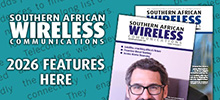04 April 2023

Luz Fernández del Rosal, international cooperation, directorate strategy and central management, BDBOS Germany; and vice-chair of TCCA’s Critical Communications Broadband Group.
The future of critical communications is on the agenda of the next World Radio Conference (WRC) that will take place in Dubai towards the end of 2023. How emergency and rescue services, police and fire brigades, utilities and other critical industries will introduce mobile broadband communications in Africa, Europe and the Middle East strongly depends on the outcome of this conference.
The outstanding properties of the frequency band 470-694MHz make it a unique opportunity for critical users to meet their additional spectrum needs for broadband. The decision of a primary allocation of this frequency band to mobile service at the WRC-23 is the first step to ensure that first responders, transport or utilities have access to the necessary communications technologies that would help them to keep us and our societies safe.
Communication is the most important instrument for critical users to coordinate their work. Traditionally, critical industries depend on highly reliable narrowband systems with limited capacity for the transmission of speech and small amounts of data. Mobile broadband will open up a wide range of new data applications that will help critical users to work more efficiently in times of operational need.
If you think about broadband as this brand-new railway that enables the transport of goods very quickly from one place to another, you can think about spectrum as the train you will need to travel on to leverage its potential. This is true irrespective of whether you use your own train, you rent one or you combine your own locomotive with rental wagons. Every possible broadband deployment model for critical industries, whether dedicated, commercial or hybrid, needs spectrum. Therefore, making spectrum available for mobile broadband for critical users will benefit us all.
The spectrum band 470-694MHz is an exceptional opportunity for deploying broadband for critical users for the following reasons.
First, its good propagation characteristics make the band especially appropriate for providing geographical coverage more efficiently, as fewer base stations are needed to cover a given area. Emergency and rescue services depend on communications systems that are available everywhere since natural disasters and catastrophes can happen everywhere and at any time.
Second, the propagation characteristics provide better indoor coverage than higher frequencies, and the ability to communicate inside buildings is crucial for critical users such as fire fighters.
“Traditionally, critical industries depend on highly reliable narrowband systems with limited capacity for the transmission of speech and small amounts of data. Mobile broadband will open up a wide range of new data applications that will help critical users to work more efficiently in times of operational need.”
Third, there is enough available bandwidth in the frequency band 470-694MHz to meet the different spectrum requirements of critical users. Those requirements vary from country to country due to national constraints and range from 2 x 10 MHz(1) to 60 MHz(2)
Fourth, the timely availability is in line with the international trends that TCCA observes in the adoption of broadband by mission critical users. Early adopters are already operational in sectors such as public safety and many more will follow in the next 5-10 years.
Fifth, the deployment of broadband in the frequency band 470-694MHz might leverage on already available critical infrastructure from previous narrowband deployments potentially reducing the overall investment costs.
Finally, apart from spectrum, standardised solutions are also required to avoid lock-in situations and enable economies of scale. The frequency band 470-694MHz already counts with a band standardised for 3GPP technologies, the LTE band 71 and 5G band n71 which are already in operation in the USA and Canada. Thus, there is already a commercial ecosystem available, which will enable the rapid development of an appropriate broadband ecosystem for critical users.
The band 470-694MHz is an outstanding opportunity and will be discussed under the agenda item 1.5 at the WRC-23. The target is to analyse the current uses and future needs in the wider band 470-960MHz and consider possible regulatory measures in 470-694MHz for Africa, Europe, and the Middle East. The band is currently allocated to the broadcast service - terrestrial television - and the programme making and special events (PMSE) – wireless microphones.
TCCA has published a joint position for the WRC-23 agenda item 1.5,(3) which advocates for a co-primary allocation of the frequency band 470-694 MHz to mobile service to help meet the long-term needs of critical users. Every public safety organisation, every mission critical network operator, every transport and utility user can and should help make this change happen. Start today the dialog with your national regulator about your spectrum needs, your communication requirements and the beneficial impact that a co-primary allocation of the band 470-694MHz would have on all critical industries.
(1) ECC/DEC/(16)02







